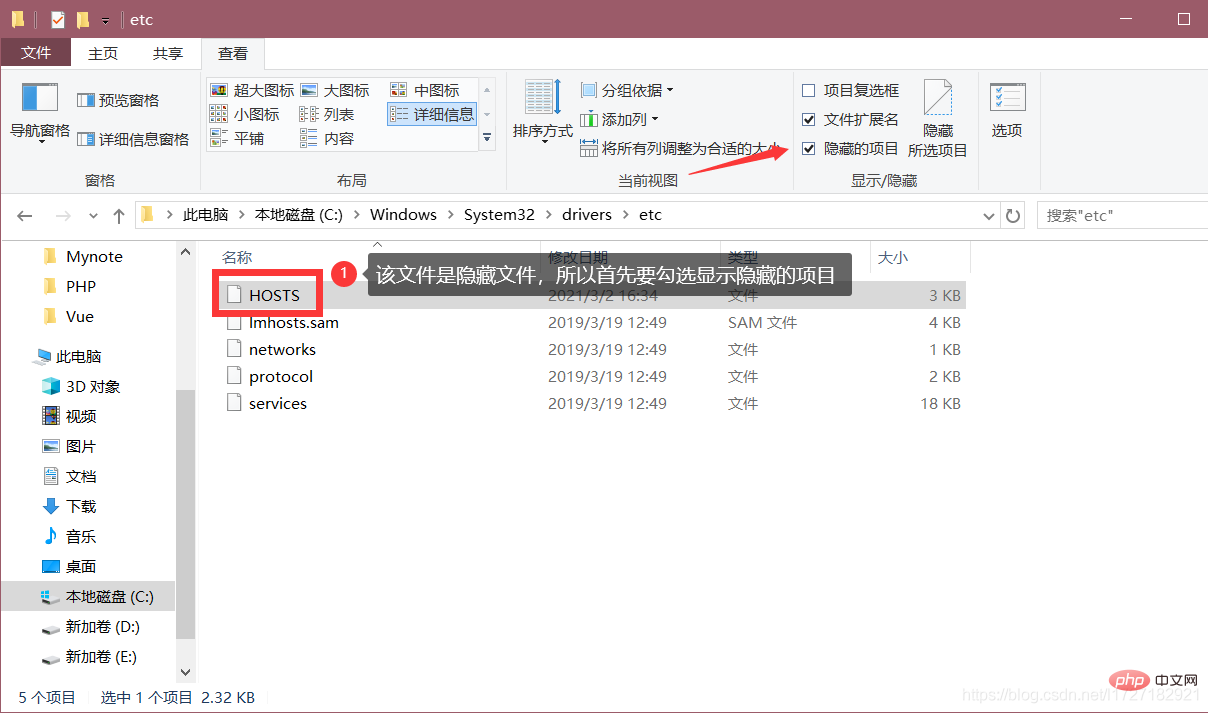 Backend Development
Backend Development
 PHP Tutorial
PHP Tutorial
 Teach you to create a virtual host and run php projects (phpstudy + wamp)
Teach you to create a virtual host and run php projects (phpstudy + wamp)
Teach you to create a virtual host and run php projects (phpstudy + wamp)
Creation of PHP environment and virtual host (phpstudy wamp)
This article involves two PHP Integrated environment
- phpstudy
- wampserver
Both of these two include mysql apache php, phpstudy is more powerful than wamp, and is very Simple and easy to use.
phpstudy is easy to use because it helps us encapsulate many tedious and error-prone operations. However, if we use it directly, we do not understand the implementation behind it, so learning wamp first can familiarize us with the principles.
1. Create a website with wamp
1.1 Understand the default website program
After the installation is completed, the tray icon is normal green. 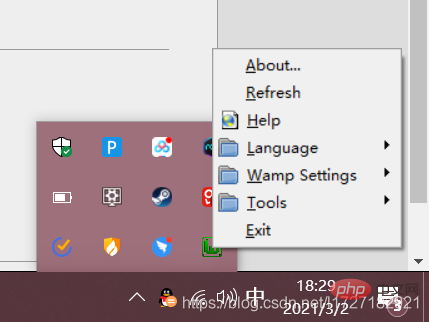
My program is installed in D:\wamp64. After finding it normal, directly access the page localhost. The default port is 80. You can ignore
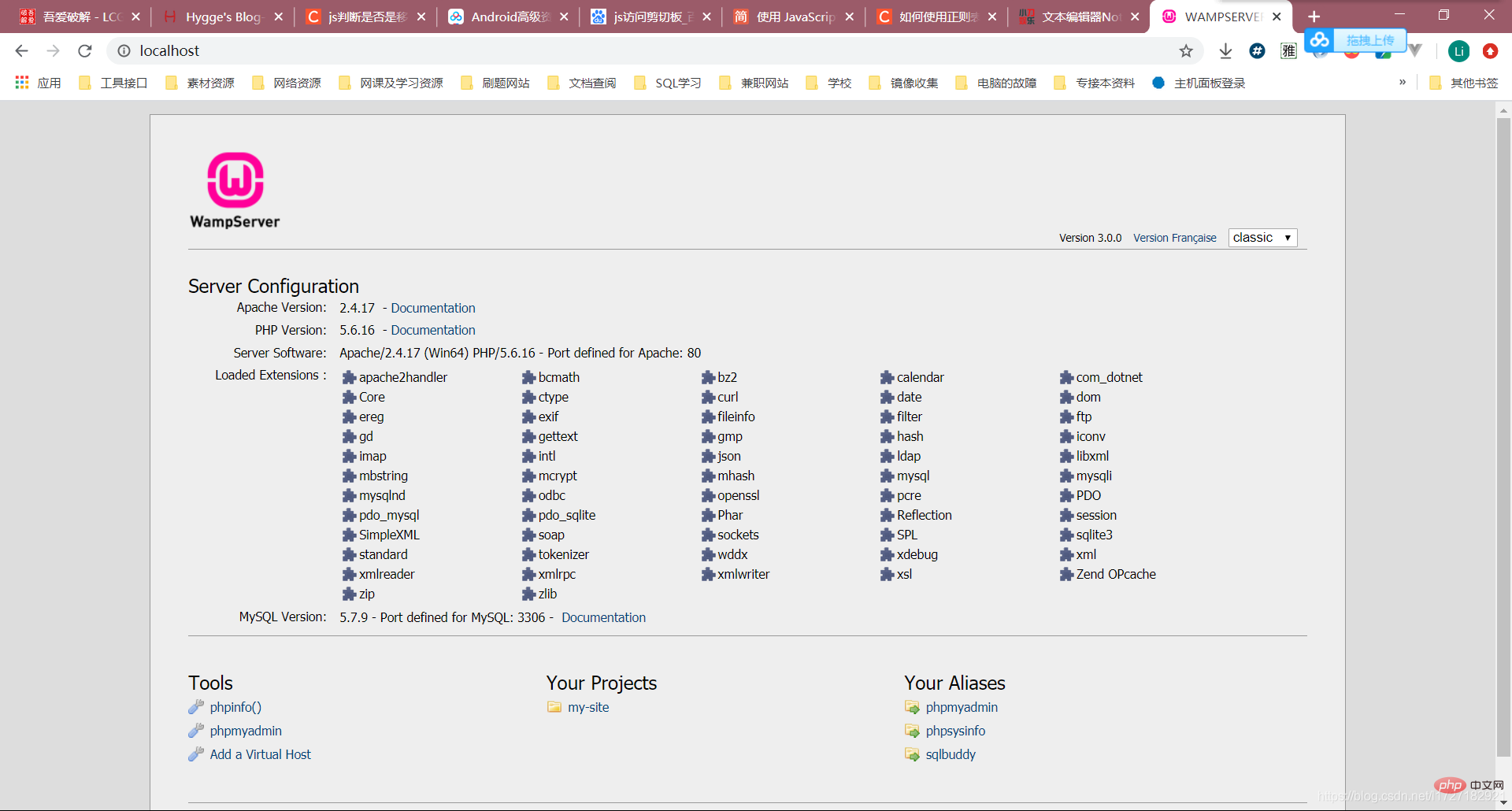
to get a normal response. This page comes from D:\wamp64\www\index.php, which is under the wamp installation directory. The www folder stores the default website programs.
1.2 Create a new virtual host
At this point we need to understand a few files first.
- hosts, file location:
C:\Windows\System32\drivers\etc
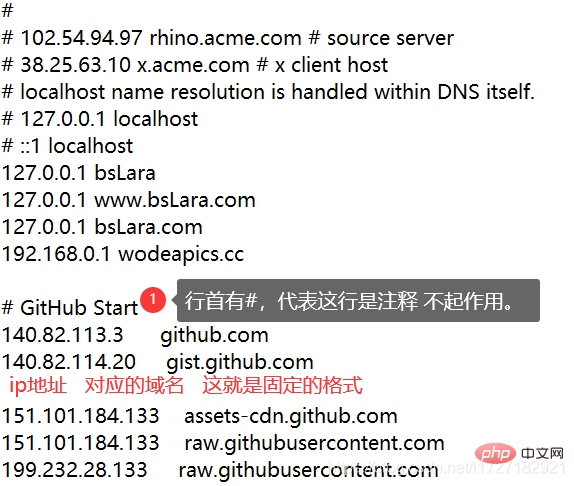
The function is to establish an associated "database" between some commonly used URL domain names and their corresponding IP addresses. When the user enters a URL that needs to be logged in in the browser, the system will first automatically start from Hosts file looks for the corresponding IP address. Once found, the system will immediately open the corresponding web page. If not found, the system will submit the URL to the DNS domain name resolution server for IP address resolution.
-
httpd.conf, file location:D:\wamp64\bin\apache\apache2.4.17\conf
This file is the configuration file of apache and generally does not need to be changed.
-
httpd-vhosts.conf, file location:D:\wamp64\bin\apache\apache2.4.17\conf\extra
This file is a virtual host file. When creating a new website, it needs to be configured in this file to take effect.
The following I have a requirement:
I think it is too wasteful to run only one program on one computer, and port 80 of my local machine is occupied. I want to open a website for ittest.com:81 to access
1) According to the function of the hosts file, when I visit test.com:81, I need it to jump directly without going. Perform dns domain name resolution
So, add a line in the hosts file according to the fixed format
# 当访问www.test.com时 , 我们告诉电脑直接解析到本机127.0.0.1 不用去dns域名解析。# :81属于端口号 不需要添加到这里127.0.0.1 www.test.com
2). The previous step only tells the computer to resolve to the local, but we haven’t done that yet. The corresponding virtual host is
, so a new virtual host needs to be configured in httpd-vhosts.conf.
<virtualhost> DocumentRoot "网站程序目录" ServerName 绑定的域名 ServerAlias 绑定的域名别名 <directory> Options FollowSymLinks ExecCGI AllowOverride All Order allow,deny Allow from all Require all granted </directory> </virtualhost>
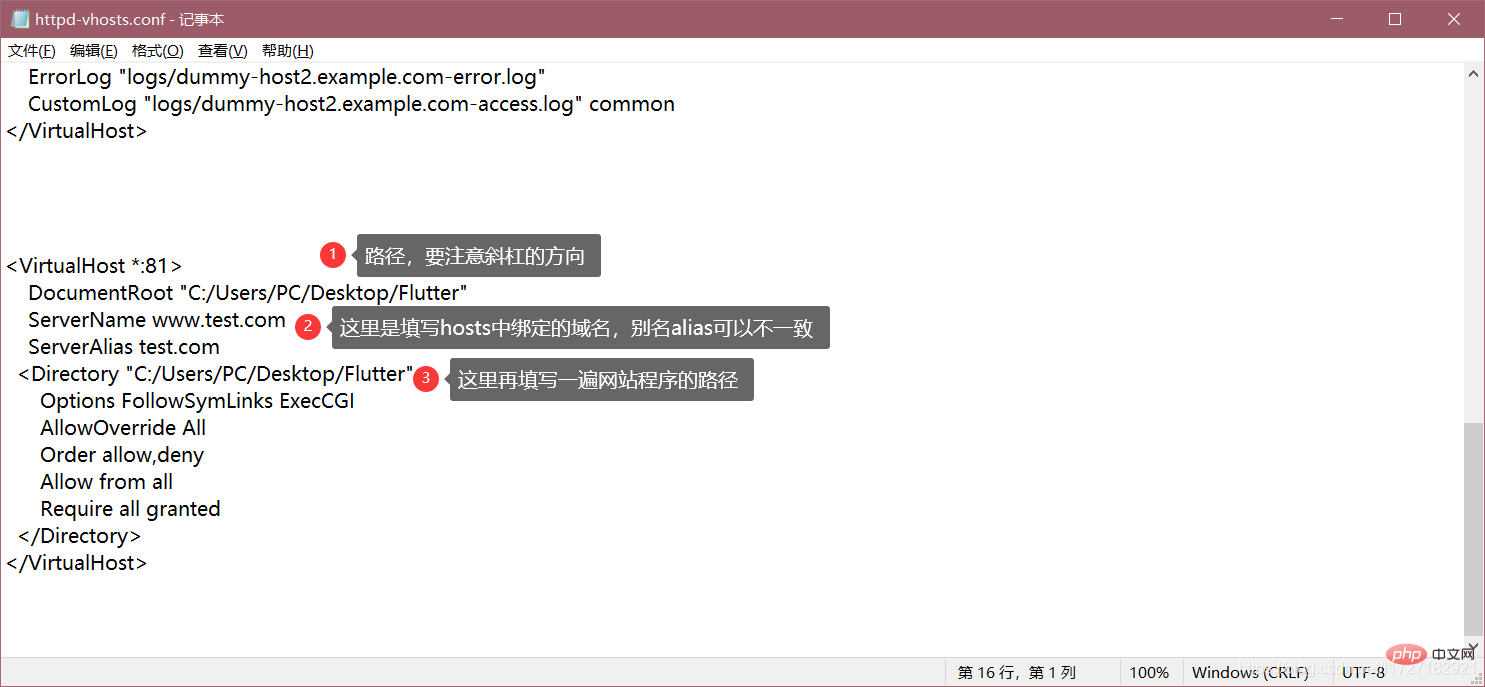
In additionVirtuaHost *:Port number
After filling in here, it will not take effect because we have not allowed apache to be enabled. Virtual host, now enable it, in the httpd.conf file
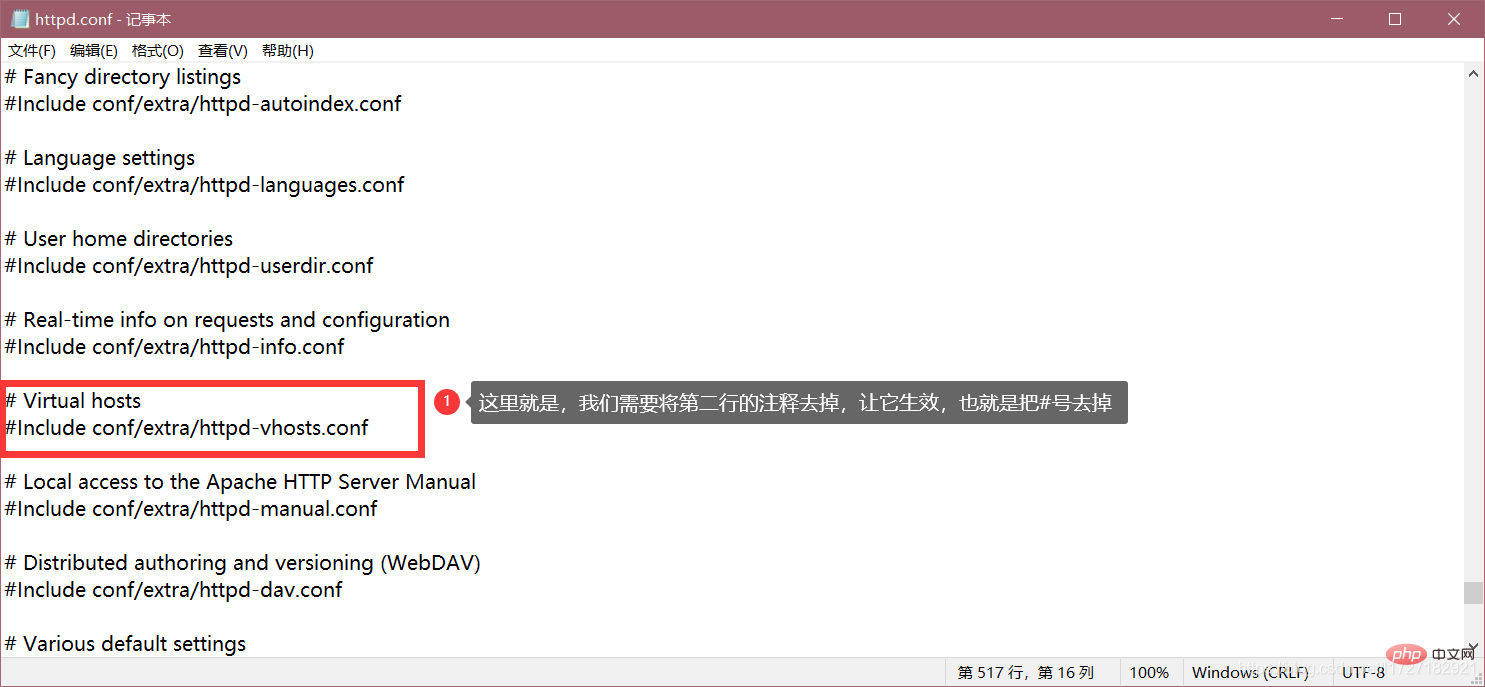
Finally set the default port of wamp's apache service:
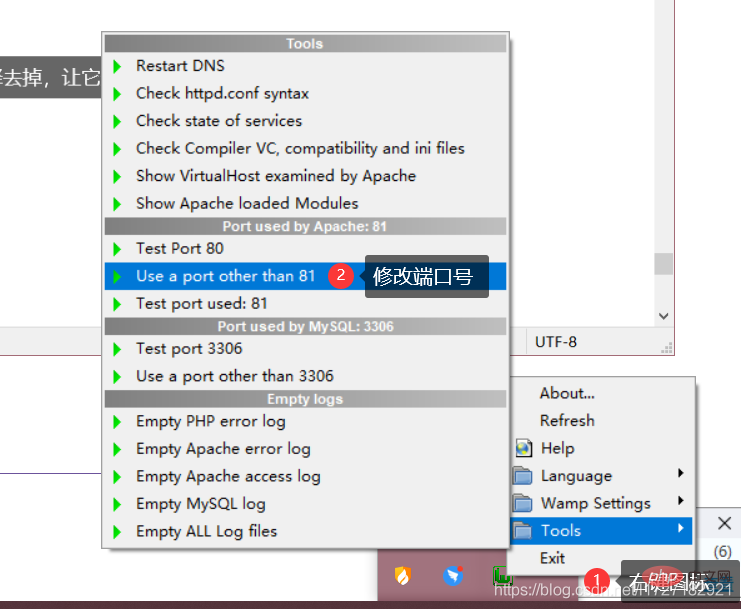

Successfully obtained response.
2. Creating a website with Phpstudy
After reading wamp, it feels very cumbersome. Next, try using phpstudy.
The demand remains unchanged, let’s create a websitewww.test.com:81,
1.1 Effect demonstration
1), directly Start apache
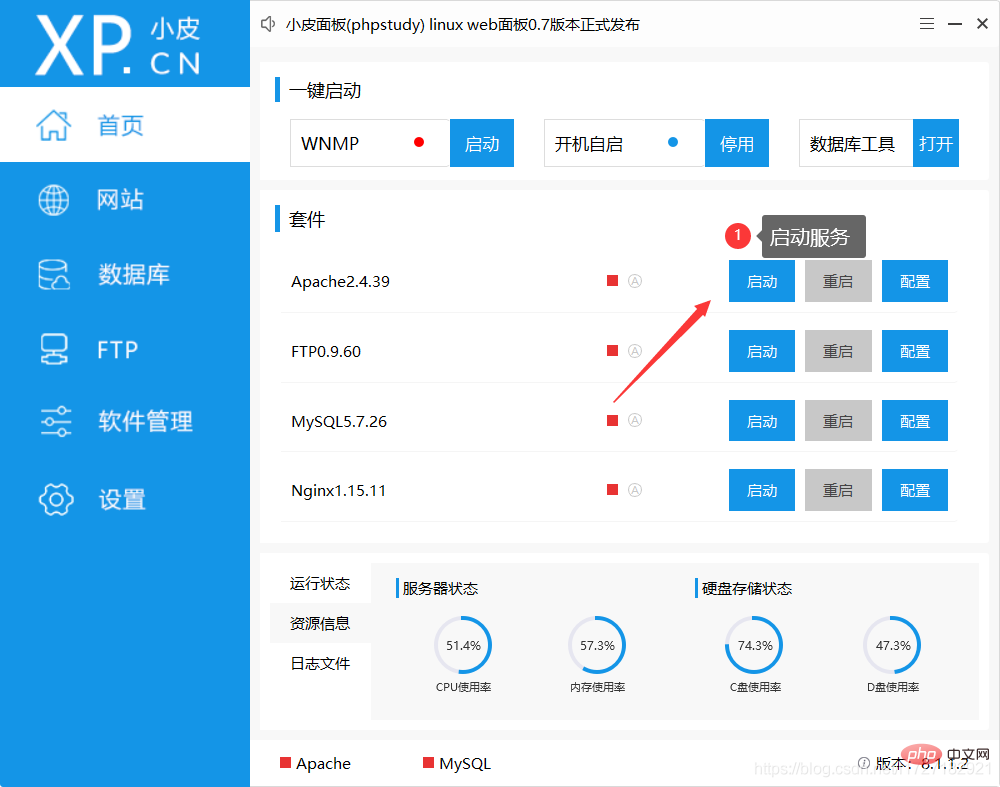
2) Create website
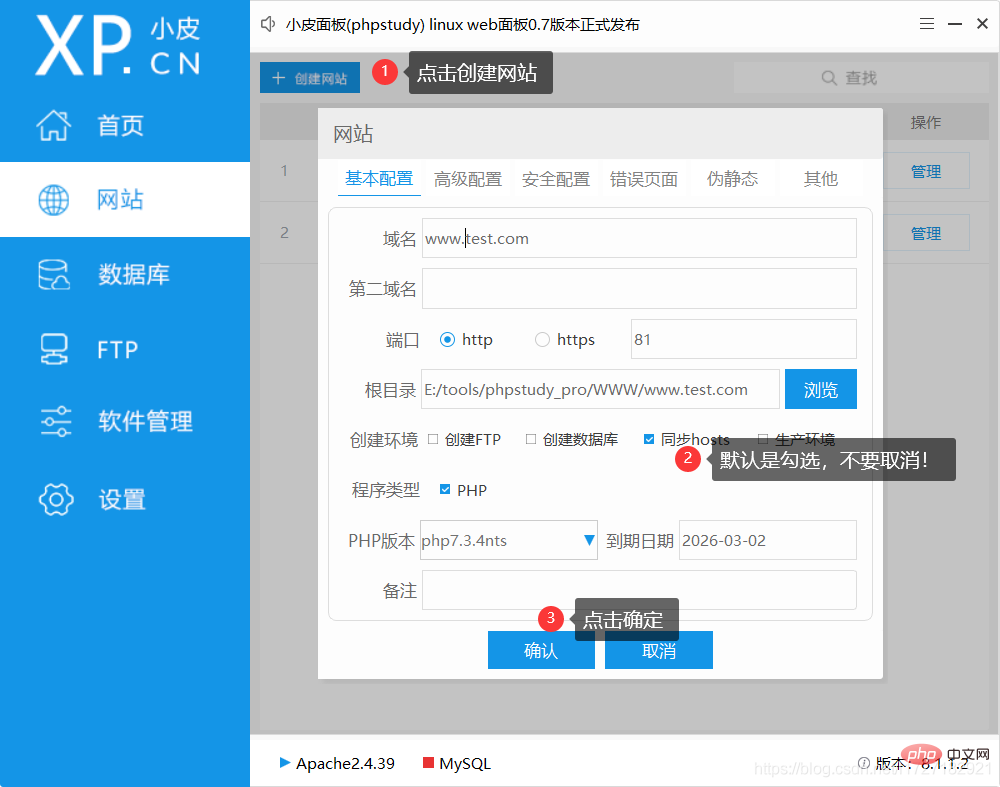
根目录选择项目的根目录
三)、查看效果

这就完成了…
1.2 配置文件查看
使用过wamp后我们知道,配置一个虚拟主机需要改三个文件,下面看一下phpstudy的操作。
一)、hosts
由于做wamp的时候已经手动添加过了,所以这个文件看不出来两者的差异。
二)、httpd.conf和vhost.conf
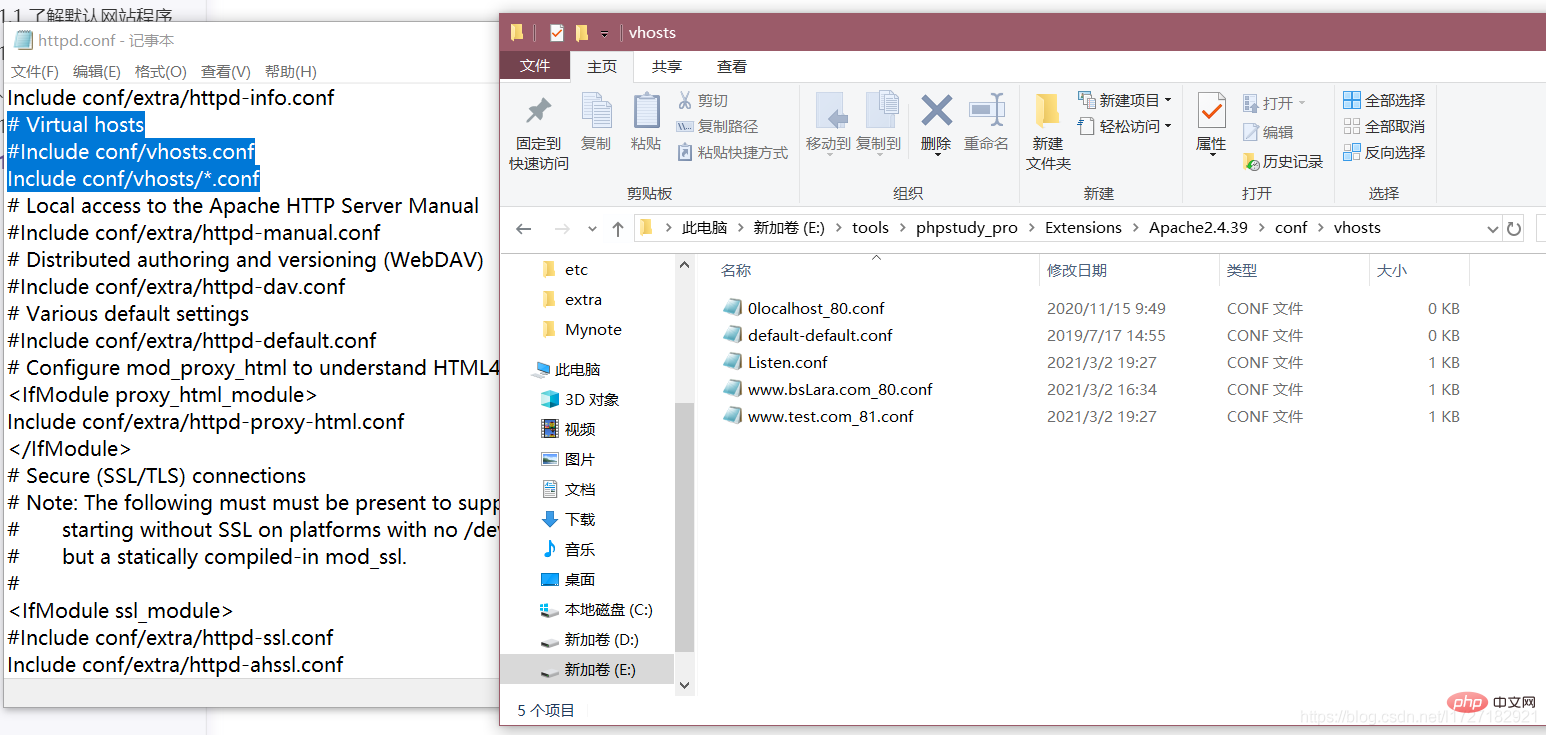
在wamp中,我们将多个虚拟主机的配置项都放在了一个文件中。
在phpstudy里,将每个网站的配置项单独抽离出个自己的文件并放到了一个文件夹中。
httpd-vhosts.conf详解
首先看下面的配置:
<virtualhost> ServerAdmin webmaster@dummy-host.example.com DocumentRoot "D:/xampp/htdocs/wherein" ServerName www.shop_dev.com ErrorLog "logs/wherein.com-error.log" CustomLog "logs/wherein.com-access.log" common <directory> Options FollowSymLinks IncludesNOEXEC Indexes DirectoryIndex index.html index.htm index.php AllowOverride all Order Deny,Allow Allow from all Require all granted </directory> </virtualhost>
ServerAdmin指令:
语法: ServerAdmin email-address|URL
用来设置服务器返回给客户端的错误信息中包含的管理员邮件地址。便于用户在收到错误信息后能及时与管理员取得联系。
ServerName指令:
语法:ServerName [scheme://] FQDN [:port]
用来设置服务器用于辨识自己的主机名和端口号。主要用于创建重定向URL。
DocumentRoot指令:
语法:DocumentRoot directory-path
用来设置httpd提供服务的目录。即你所在项目入口处的文件夹。
ErrorLog指令:
语法: ErrorLog file-path
来设置当服务器遇到错误时记录错误日志的文件。如果file-path不是以/开头的绝对路径,那么将会被认为是一个相对于ServerRoot的相对路径。
CustomLog指令:
语法: ErrorLog file-path common
设置日志文件,并指明日志文件所用的格式(通常通过格式的名字)。
为主目录或虚拟目录设置权限。
特性:
Options FollowSymLinks IncludesNOEXEC Indexes
| 命 令 | 说 明 |
|---|---|
| Indexes | 允许目录浏览当客户仅指定要访问的目录,但没有指定要访问目录下的哪个文件,而且目录下不存在默认文档时,Apache以超文本形式返回目录中的文件和子目录列表(虚拟目录不会出现在目录列表中) |
| MultiViews | 允许内容协商的多重视图MultiViews其实是Apache的一个智能特性。当客户访问目录 中一个不存在的对象时,如访问“http://192.168.66.6/data/a”,则Apache会查找这个目录下所有a.*文件。由于 data目录下存在a.gif文件,因此Apache会将a.gif文件返回给客户,而不是返回出错信息 |
| All | All包含了除MultiViews之外的所有特性,如果没有Options语句,默认为All |
| ExecCGI | 允许在该目录下执行CGI脚本 |
| FollowSymLinks | 可以在该目录中使用符号连接 |
| Includes | 允许服务器端包含功能 |
| IncludesNoExec | 允许服务器端包含功能,但禁用执行CGI脚本 |
一旦定义允许目录浏览,就会将Web站点的文件夹和文件名结构暴露给黑客。目录浏览还会允许黑客浏览文件并掌握服务器配置信息,所以指定该权限往往带来安全性上的隐患。除非有充足的理由要使用目录浏览,否则应该禁用它。
DirectoryIndex index.html index.htm index.php
设置访问目录后进入的默认文件
AllowOverride all
定义位于每个目录下.htaccess(访问控制)文件中的指令类型。none为禁止使用.htaccess文件
Order Deny,Allow
Allow from all
设置缺省的访问权限与Allow和Deny语句的处理顺序
allow, deny:缺省禁止所有客户机的访问,且Allow语句在Deny语句之前被匹配。如果某条件既匹配Deny语句又匹配Allow语句,则Deny语句会起作用(因为Deny语句覆盖了Allow语句)。
deny, allow:缺省允许所有客户机的访问,且Deny语句在Allow语句之前被匹配。如果某条件既匹配Deny语句又匹配Allow语句,则Allow语句会起作用(因为Allow语句覆盖了Deny语句)。
eg.
Order deny ,allow Deny from baidu.com Deny from 192.168.66.6除了来自baidu.com域和ip地址为192.168.66.6的客户机外,允许所有客户机访问 Order deny ,allow Allow from 192.168.66.6 Deny from 192.168.66.1既匹配Deny语句又匹配Allow语句,由于allow语句覆盖了deny语句,所以是允许所有客户机访问 Order allow ,deny Allow from 192.168.66.6 Deny from 192.168.66.1既匹配Deny语句又匹配Allow语句,由于deny语句覆盖了allow语句,所以是禁止所有客户机访问
推荐学习:《PHP视频教程》
The above is the detailed content of Teach you to create a virtual host and run php projects (phpstudy + wamp). For more information, please follow other related articles on the PHP Chinese website!

Hot AI Tools

Undresser.AI Undress
AI-powered app for creating realistic nude photos

AI Clothes Remover
Online AI tool for removing clothes from photos.

Undress AI Tool
Undress images for free

Clothoff.io
AI clothes remover

Video Face Swap
Swap faces in any video effortlessly with our completely free AI face swap tool!

Hot Article

Hot Tools

Notepad++7.3.1
Easy-to-use and free code editor

SublimeText3 Chinese version
Chinese version, very easy to use

Zend Studio 13.0.1
Powerful PHP integrated development environment

Dreamweaver CS6
Visual web development tools

SublimeText3 Mac version
God-level code editing software (SublimeText3)

Hot Topics
 1666
1666
 14
14
 1425
1425
 52
52
 1325
1325
 25
25
 1272
1272
 29
29
 1251
1251
 24
24
 PHP and Python: Comparing Two Popular Programming Languages
Apr 14, 2025 am 12:13 AM
PHP and Python: Comparing Two Popular Programming Languages
Apr 14, 2025 am 12:13 AM
PHP and Python each have their own advantages, and choose according to project requirements. 1.PHP is suitable for web development, especially for rapid development and maintenance of websites. 2. Python is suitable for data science, machine learning and artificial intelligence, with concise syntax and suitable for beginners.
 PHP in Action: Real-World Examples and Applications
Apr 14, 2025 am 12:19 AM
PHP in Action: Real-World Examples and Applications
Apr 14, 2025 am 12:19 AM
PHP is widely used in e-commerce, content management systems and API development. 1) E-commerce: used for shopping cart function and payment processing. 2) Content management system: used for dynamic content generation and user management. 3) API development: used for RESTful API development and API security. Through performance optimization and best practices, the efficiency and maintainability of PHP applications are improved.
 PHP: A Key Language for Web Development
Apr 13, 2025 am 12:08 AM
PHP: A Key Language for Web Development
Apr 13, 2025 am 12:08 AM
PHP is a scripting language widely used on the server side, especially suitable for web development. 1.PHP can embed HTML, process HTTP requests and responses, and supports a variety of databases. 2.PHP is used to generate dynamic web content, process form data, access databases, etc., with strong community support and open source resources. 3. PHP is an interpreted language, and the execution process includes lexical analysis, grammatical analysis, compilation and execution. 4.PHP can be combined with MySQL for advanced applications such as user registration systems. 5. When debugging PHP, you can use functions such as error_reporting() and var_dump(). 6. Optimize PHP code to use caching mechanisms, optimize database queries and use built-in functions. 7
 PHP vs. Python: Understanding the Differences
Apr 11, 2025 am 12:15 AM
PHP vs. Python: Understanding the Differences
Apr 11, 2025 am 12:15 AM
PHP and Python each have their own advantages, and the choice should be based on project requirements. 1.PHP is suitable for web development, with simple syntax and high execution efficiency. 2. Python is suitable for data science and machine learning, with concise syntax and rich libraries.
 The Enduring Relevance of PHP: Is It Still Alive?
Apr 14, 2025 am 12:12 AM
The Enduring Relevance of PHP: Is It Still Alive?
Apr 14, 2025 am 12:12 AM
PHP is still dynamic and still occupies an important position in the field of modern programming. 1) PHP's simplicity and powerful community support make it widely used in web development; 2) Its flexibility and stability make it outstanding in handling web forms, database operations and file processing; 3) PHP is constantly evolving and optimizing, suitable for beginners and experienced developers.
 PHP vs. Other Languages: A Comparison
Apr 13, 2025 am 12:19 AM
PHP vs. Other Languages: A Comparison
Apr 13, 2025 am 12:19 AM
PHP is suitable for web development, especially in rapid development and processing dynamic content, but is not good at data science and enterprise-level applications. Compared with Python, PHP has more advantages in web development, but is not as good as Python in the field of data science; compared with Java, PHP performs worse in enterprise-level applications, but is more flexible in web development; compared with JavaScript, PHP is more concise in back-end development, but is not as good as JavaScript in front-end development.
 PHP and Python: Code Examples and Comparison
Apr 15, 2025 am 12:07 AM
PHP and Python: Code Examples and Comparison
Apr 15, 2025 am 12:07 AM
PHP and Python have their own advantages and disadvantages, and the choice depends on project needs and personal preferences. 1.PHP is suitable for rapid development and maintenance of large-scale web applications. 2. Python dominates the field of data science and machine learning.
 PHP and Python: Different Paradigms Explained
Apr 18, 2025 am 12:26 AM
PHP and Python: Different Paradigms Explained
Apr 18, 2025 am 12:26 AM
PHP is mainly procedural programming, but also supports object-oriented programming (OOP); Python supports a variety of paradigms, including OOP, functional and procedural programming. PHP is suitable for web development, and Python is suitable for a variety of applications such as data analysis and machine learning.



